aka: Rolling Tail Skid
The concept is for a rubber roller (caster) to replace the existing stationary tie-down eye bolt (mooring ring) on small, general aviation (GA) tricycle gear airplanes. The purpose is to provide substantially more cushioning with reduced friction when and if the rear section contacts the runway during short field takeoffs and/or when porpoising after a landing. In short, any time the moving tail cone may come into contact with a stationary hard surface, such as a runway, during normal operation.

The designer's intent was to provide a means of protecting his personal airplane, a Cessna 150, from damage during takeoffs. Since his plane was equipped with the Demers Super Tips STOL system it had the ability for achieving rather steep short field takeoffs when 10 degrees of flaps were applied. Inevitably, this resulted in the tailcone eye bolt contacting the runway.
If you examine most any older trainer-type plane's tailcone eye bolt you will usually find part of the "eye" has been ground down from contact with the runway.
Here is one example:
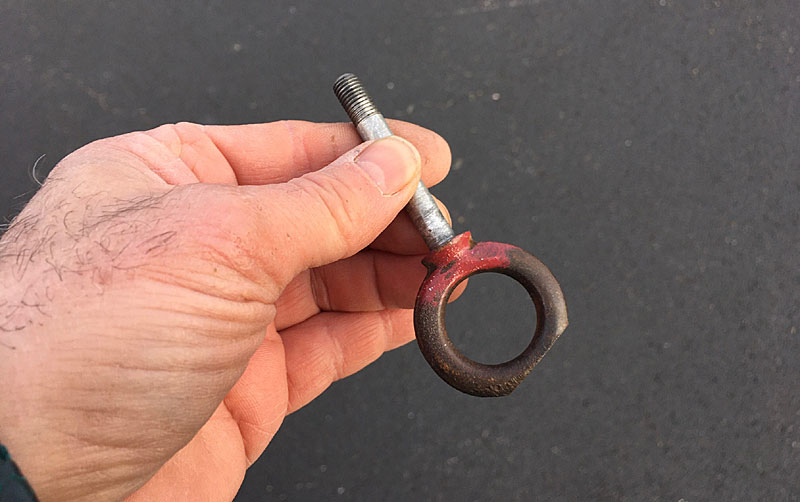
The cost for a new, factory-supplied, eye bolt or mooring ring for the Cessna 100 series airplane is as much as $345. Cheaper third-party substitutions can be had, of course, but none offer any improvement.
One, rather inadequate, solution to the scraping issue is by using a commercially-available device called a tail skid. This consists of a section of either painted or stainless steel flat stock bent to form a sort of J shape. The existing eye bolt is used to secure the tail skid to the tail cone. The versions commonly available often require additional washers to hold them in place, they tend to rotate, due to poor fit and they sometimes need to be modified to get the eye bolt to fit correctly. By their very shape they can also produce undue stress on the mooring ring.
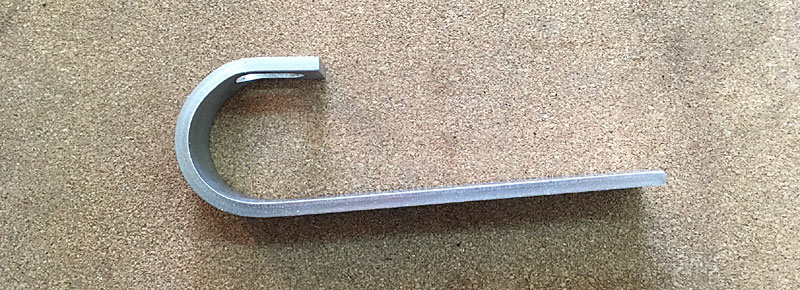
The prototype rolling tail skid, shown below, can be constructed of simple and easily obtainable parts available from any home-improvement type store. Some fabrication is also required using basic tools. As shown, the prototype part weighs about eight ounces.
Please note, the prototype was designed for a Cessna 150 and may need some customizing if tested on other model airplanes.

Parts list for the Cessna 150 prototype, as shown in this artitle:
1) Caster, 2" diameter x 1" wide, plastic & rubber (exact composition and size TBD)
1) Hex Bolt, 5/6" x 24 thread, 2.5" long, #8 (replaces the tie down eye bolt)
1) Hex Bolt, 1/4 x 20, 2" long, stainless steel (cut to size for caster frame)
1) Locking Nut, 1/4 x 20, stainless steel
4) Bolt, 8-28 x 1/2" long, stainless steel
4) Lock Nut, 8-28, stainless steel
4) #8 steel washer, stainless steel
The original caster came with a non-removable steel "axel" which was ground off and replaced with the 1/4 x 20 hex bolt. This will allow for easy replacement of the roller, as it wears. Also, since 2" diameter x 1" wide is a standard size for casters it may be possible, and even desirable, to source a different version for testing. For instance, an all-aluminum caster, like that used on a rolling floor jack, may offer more longevity over the plastic and rubber version used in this prototype. The trade-off will be the loss of additional shock protection offered by the rubber caster. Alternatively, a caster made with a solid PVC inner core and rubber outer lining can work to meet both goals of strength and shock absorption. Further testing will indicate whether the caster structure/size needs to be altered.
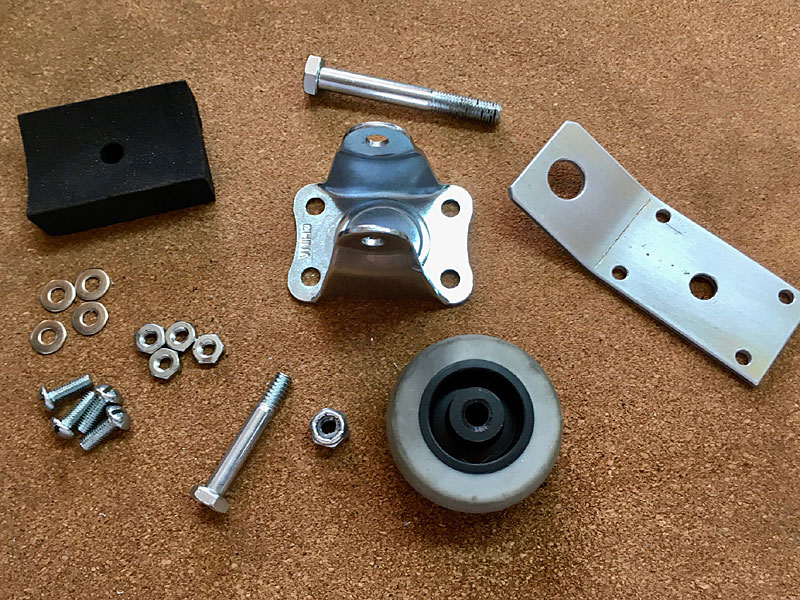
The plate that forms the original "eye bolt" replacement is made from 1/8" aluminum. It needs to be custom made to fit the mounting hole locations in the roller frame. A slight bend of approximately 30 degrees is necessary along with a 1/2" hole drilled into the bend to accommodate a standard tie down strap hook.
A 5/16" hole is drilled into the center of the top of the roller frame AND through and into this plate to allow for the bolt to secure the roller to the bottom of the tailcone section.

The shock absorbing spacer that fits between the tailcone section and the roller needs to be custom made from a small piece of hard rubber. Something cut from and old tire can work. The top is fashioned to conform (loosely) to the bottom of the tailcone to keep the roller from turning side to side. It will be attached to the top of the roller frame with contact cement. For this prototype, a 2" diameter hole saw was used to bore out a section of hard rubber and the final part, seen here, was cut down from there.

The backside of the shock mount is counter sunk at the positions of the four #8 bolt heads to allow the mount to sit flush with the roller frame for good adhesion of the contact cement.
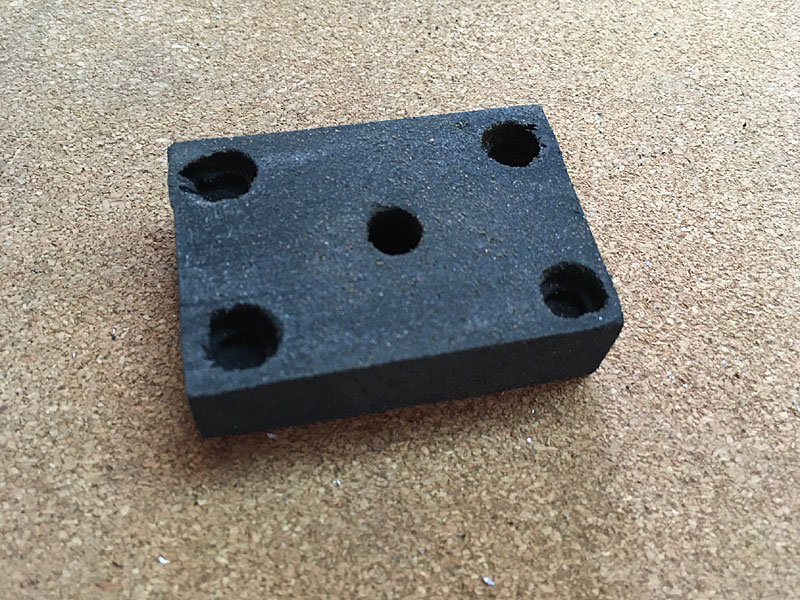
Here is how the final prototype might look when fitted to an airplane.

This test shows how the roller will contact the runway and the clearance of the
tie-down tab when the airplane's tail fin is lowered to the ground as it would be in a typical short field take off attitude.
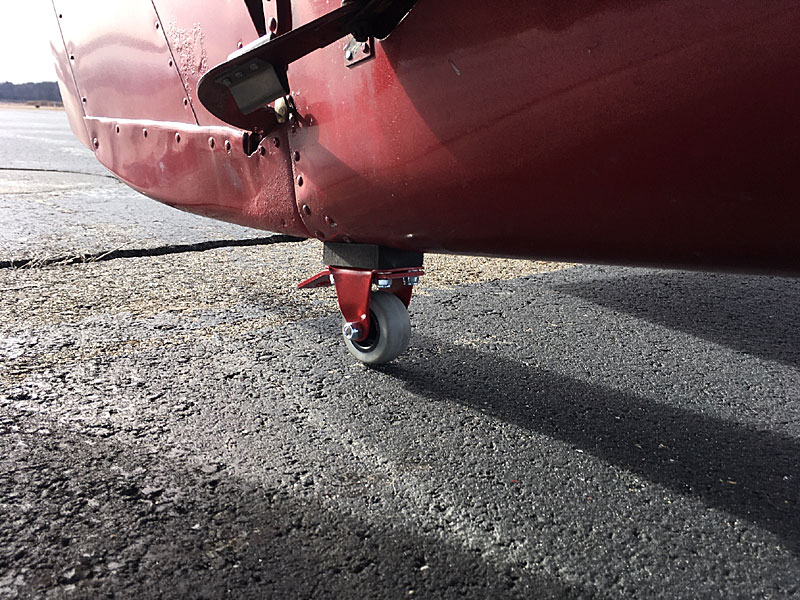
DISCLAIMER: No STC documentation or PMA certification is provided, nor is it implied. This article is provided strictly for entertainment purposes, only. If you install parts on your certificated airplane which are not FAA approved, you do so at your own risk. I will not be held responsible for the outcome.
Contact
Cessna rolling tail skid, tricycle gear airplane, tailcone fin roller, tail cone fin tie down eye hook, plane's tail cone, tail cone tie down eye bolt, tricycle landing gear, short field takeoff, tail cone modification, tailskid modification, tailwheel airplane, hull damage, GA general aviation airplane, gravel bar landings, STOL, tailstrike, short field take off and landing, Cessna mooring ring, back country flying, airplane tail strike, tailstrike protection device, Demers Super Tips, damage to tail cone, soft field landing operations, rolling tail skid modification